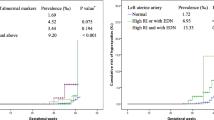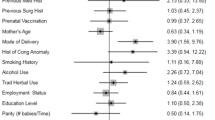Abstract
Objective
To investigate pregnancy outcome in patients with condyloma acuminata.
Methods
A retrospective cohort study comparing pregnancy outcome of women with and without condyloma acuminata was performed. A sub-group analysis was performed between patients with localized disease (n = 40), extended disease (n = 25) and no condyloma acuminata (n = 227,202).
Results
Using a multivariate logistic regression model, condyloma acuminata was significantly associated with cesarean delivery (OR = 3.4; 95% CI 1.9–5.8; P < 0.001), nulliparity (OR = 4.8; 95% CI 2.6–9.0; P < 0.001), and Jewish ethnicity (vs. Bedouin Arabs; OR = 2.3; 95% CI 1.3–4.1; P < 0.001). A significant linear association was found between the three subgroup (extended condyloma, localized condyloma and no condyloma) and cesarean delivery (40.0% in the extended disease vs. 32.5% in the localized disease vs. 13.0% in the comparison group P < 0.001). No significant differences were noted between the groups in terms of perinatal outcomes, such as low Apgar score (<7) at 1 min (4.2 vs. 1.6%; P = 0.298) and 5 min (0.6 vs. 0.0% P = 0.534) and perinatal mortality (1.4 vs. 1.5% P = 0.912).
Conclusions
Women with condyloma acuminata are at an increased risk for cesarean delivery, while the risk for cesarean delivery is higher for pregnancies with extended when compared with localized disease. Nevertheless, condyloma acuminata is not associated with adverse perinatal outcome.
Similar content being viewed by others
References
Ault KA (2006) Epidemiology and natural history of human papillomavirus infections in the female genital tract. Infect Dis Obstet Gynecol 2006(Suppl):40470
Center of Disease Control and Prevention (1999) Prevention of genital HPV infection and sequelae: report of an external consultants’ meeting. Centers for Disease Control and Prevention, Atlanta, December 1999
Willey DJ, Douglas J, Beutner K (2002) External genital warts: diagnosis, treatment and prevention. Clin Infect Dis 35:S210
Arena S, Marconi M, Ubertosi M, Frega A, Arena G, Villani C (2002) HPV and pregnancy: diagnostic methods, transmission and evolution. Minerva Ginecol 54(3):225–237
Hagensee ME, Slavinsky J 3rd, Gaffga CM, Suros J, Kissinger P, Martin DH (1999) Seroprevalence of human papillomavirus type 16 in pregnant women. Obstet Gynecol 94(5 Pt 1):653–658
Fife KH, Katz BP, Brizendine EJ (1999) Cervical human papillomavirus deoxyribonucleic acid persists throughout pregnancy and decreases in the post partum period. Am J Obstet Gynecol 180:1110
Snyder RR, Hammond TL, Hankuns GDV (1990) Human papillomavirus associated with poor healing of episiotomy repairs. Obstet Gynecol 76:664
Silverberg MJ, Thorsen P, Lindeberg H, Grant LA, Shah KV (2003) Condyloma in Pregnancy is strongly predictive of juvenile-onset recurrent respiratory papillomatosis. Obstet Gynecol 101(4):645–652
Tseng CJ, Liang CC, Soong YK (1998) Perinatal transmission of human papillomavirus in infants: relationship between infection rate and mode of delivery. Obstet Gynecol 91:92
Gomez LM, Ma Y, Ho C, McGrath CM, Nelson DB, Parry S (2008) Placental infection with human papillomavirus is associated with spontaneous preterm delivery. Hum Reprod 23(3):709–715
Savoca S, Nardo LG, Rosano TF, D’Agosta S, Nardo F (2001) CO(2) laser vaporization as primary therapy for human papillomavirus lesions. A prospective observational study. Acta Obstet Gynecol Scand 80(12):1121–1124
Dickstein Y, Ohel I, Levy A, Holcberg G, Sheiner E (2008) Lack of prenatal care: an independent risk factor for perinatal mortality among macrosomic newborns. Arch Gynecol Obstet 277(6):511–514
Feldman I, Friger M, Wiznitzer A, Mazor M, Holcberg G, Sheiner E (2009) Is oligohydramnios more common during the summer season? Arch Gynecol Obstet 280(1):3–6
Conflict of interest statement
None.
Author information
Authors and Affiliations
Corresponding author
Additional information
Performed in part of Eyal Cohen’s MD requirements.
Rights and permissions
About this article
Cite this article
Cohen, E., Levy, A., Holcberg, G. et al. Perinatal outcomes in condyloma acuminata pregnancies. Arch Gynecol Obstet 283, 1269–1273 (2011). https://doi.org/10.1007/s00404-010-1558-2
Received:
Accepted:
Published:
Issue Date:
DOI: https://doi.org/10.1007/s00404-010-1558-2




